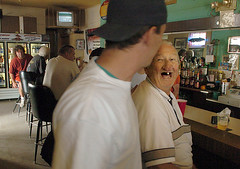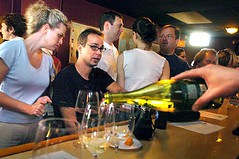Change is Change, but is Change Race or Class?
 Frank Haggerty (right) has a laugh and a brew on a Tuesday, which is 25-cent beer day for those over 55 at L.P. Docks.(Sun photo by Elizabeth Malby)Aug. 23, 2005
Frank Haggerty (right) has a laugh and a brew on a Tuesday, which is 25-cent beer day for those over 55 at L.P. Docks.(Sun photo by Elizabeth Malby)Aug. 23, 2005Paul Johnson alerted me to an article in today's Baltimore Sun before I had time to pick up a copy. The article, "Raising the bar: Fort Avenue's blue-collar saloons, where residents socialized, groused and caroused, are giving way to bars catering to an increasingly gentrified neighborhood," has a great photo gallery associated with it, as well as an excellent graphic showing all the bars on Fort Avenue (I wish I had someone on staff to do graphics like this for me... such would have been excellent to illustrate the "Commerz in the hood" series).
The point here is that "gentrification" is really about change. As you can imagine, I've written about this a lot, especially in the sum up entry from last July "More about Contested Space--"Gentrification"." This is merely one more example of what I call "Gentrification Effect #2":
(2) change and different people coming into a neighborhood -- most importantly, different people from those currently in residence (the differences--race, class, ethnicity, levels of educational attainment, attitudes toward the urban experience, etc.--are usually not "celebrated" (I make this point because I still remember first being taught about diversity and multiculturalism in 7th grade, and I specifically remember the "melting pot" and "celebration of differences" phrase -- I have a hard time seeing the celebration, at least in DC).
In DC, people look all too conveniently at "color" or race in trying to come to terms with this. The article "Whose H Street Is It, Anyway?," from the Post, continues to generate discussion and letters to the Hill Rag and an op-ed in the Voice of the Hill (!!!!!!!!!!!!!!!!!!!!!!!!!) saying that no, the issue on H Street is not class, but race.
How would this writer explain what's happening on Fort Avenue in Baltimore, where the issue is one of changing SES, where businesses targeting white lower- and working-class customers are being transformed into places for high-upper and middle-class "white" customers? Or what I have written before about African-Americans in the Shaw neighborhood fighting either the continuation or recognition of African-owned businesses. Hey they're both "black" aren't they? Or is that not the issue? For the latter issue, see "Revitalizing places that are contested spaces," from March.
 Erin and Matt Filipovich discuss the next drink selection during a recent wine-tasting at the Vine, one of the growing number of upscale bars along the Fort Avenue corridor. Some longtime residents bemoan the loss of working-class neighborhood bars. (Sun photo by Elizabeth Malby) Aug. 25, 2005
Erin and Matt Filipovich discuss the next drink selection during a recent wine-tasting at the Vine, one of the growing number of upscale bars along the Fort Avenue corridor. Some longtime residents bemoan the loss of working-class neighborhood bars. (Sun photo by Elizabeth Malby) Aug. 25, 2005 Index Keywords: contested-spaces



0 Comments:
Post a Comment
<< Home